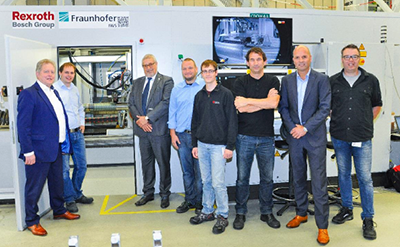 Prof. Dr. Eckhard Beyer, head of the Fraunhofer Institute for Material and Beam Technology IWS in Dresden, officially released the upgraded laser cladding process at Bosch Rexroth’s cylinder plant in the Netherlands. To develop and install this upgraded process, Bosch Rexroth and the Institute have closely worked together. The result: a unique machine which is able to coat cylinder rods of up to 19 meters with an economically laser-applied Enduroq coating, serving as a cost efficient and reliable alternative for the known nickel-chromium layers.
Prof. Dr. Eckhard Beyer, head of the Fraunhofer Institute for Material and Beam Technology IWS in Dresden, officially released the upgraded laser cladding process at Bosch Rexroth’s cylinder plant in the Netherlands. To develop and install this upgraded process, Bosch Rexroth and the Institute have closely worked together. The result: a unique machine which is able to coat cylinder rods of up to 19 meters with an economically laser-applied Enduroq coating, serving as a cost efficient and reliable alternative for the known nickel-chromium layers.
In the latest development in overlay welding techniques, laser cladding, a high power laser applies corrosion and/or wear resistant layers on the surface of cylinder rods. Specially composed substrates are fed into the welding zone of the coating machinery, melted by means of the laser, and adhered to the melted top layer material of the rod. This results in a highly reliable cylinder rod coating based on metallic adhesion of the materials, at Bosch Rexroth also known as Enduroq coating. The coating machine at Bosch Rexroth was developed in close cooperation with the Fraunhofer Institute in Dresden, and can at the moment be considered a unique piece of equipment in the world. The heavy duty diode-laser that is used dramatically decreasing the cycle times of this process compared to other coating techniques. As a result of the high speed of the process and the typical characteristics of the laser, the heath that is exerted onto the cylinder rod is as limited as possible, making sure that the characteristics and dimensions of the basic material remain in an optimal shape. Depending on the desired result, such as improved corrosion resistance chemical resistance or better protection against wear (erosion), special powders and optimized parameter settings can be selected.
The coating machine at Bosch Rexroth was developed in close cooperation with the Fraunhofer Institute in Dresden, and can at the moment be considered a unique piece of equipment in the world. The heavy duty diode-laser that is used dramatically decreasing the cycle times of this process compared to other coating techniques. As a result of the high speed of the process and the typical characteristics of the laser, the heath that is exerted onto the cylinder rod is as limited as possible, making sure that the characteristics and dimensions of the basic material remain in an optimal shape. Depending on the desired result, such as improved corrosion resistance chemical resistance or better protection against wear (erosion), special powders and optimized parameter settings can be selected.
Unique machinery
According to Bernd Bodenstedt, Technical Plant Manager at Bosch Rexroth in Boxtel, we can speak of a unique development. “This machine is not even commercially available on the market. Our goal of already further developing this machinery and technology was not only to expand our technical capabilities and the range of coatings, but also to improve efficiency of our coating process in general. Two key factors have contributed to this result. Firstly, we have increased the power density of the laser source, resulting in a considerably wider melting pool than other coating processes. Secondly, production capacity has increased by enabling higher powder-feeding speeds in both the radial and the axial direction.”
“The laser cladding process has been put in operation late 2016, and results have been promising ever since. This is why we immediately searched for further expansion possibilities. Together with the Fraunhofer Institute we have been able to do so, and both deepened as widened our so called process-window, resulting in a less critical and more stable process – an enormous quality improvement. Furthermore, we have specifically addressed the challenge of realizing an economical alternative for the known nickel-chromium based coatings. One important pre-requisite for example was the installation of a pre-heating induction system.
Induction pre-heating
Arthur Brussaard, Product Unit Director Cylinder for Bosch Rexroth, explains what the recent expansion implies. “Until now, we used laser cladding exclusively for applying very wear resistant layers or the advanced and ultra-corrosion resistant Enduroq 3 layer, which is most suitable for application in the offshore market. However, as the process and used materials remained quite costly, we could not yet substitute the economically viable nickel-chromium coating. To realize this, the process needed to be upgraded and extended with an induction-based heating system. To obtain a solid adhesion in the welding process of some selected powders, it is required to pre-heat the cylinder rod.”
“Also together with the Faunhofer Institute, we have developed a number of new coating materials and powders, therewith significantly expanding our portfolio of applied coatings – one of which being the economical alternative for nickel-chromium coating. These developments enables us to apply our extended range of Enduroq coatings onto rods with dimensions of up to 19 meters length and 600mm in diameter. Together with the optimal selection of seals and guiding strips and the right fluid, we will again be able to manufacture the highest quality cylinders, ensuring the longest possible lifetime.”
Bosch Rexroth
www.boschrexroth.com
Filed Under: Mobile Hydraulic Tips